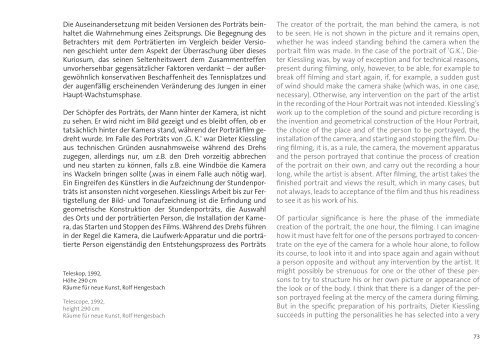DIETER KIESSLING - home
DIETER KIESSLING - home
DIETER KIESSLING - home
Erfolgreiche ePaper selbst erstellen
Machen Sie aus Ihren PDF Publikationen ein blätterbares Flipbook mit unserer einzigartigen Google optimierten e-Paper Software.
Die Auseinandersetzung mit beiden Versionen des Porträts beinhaltet<br />
die Wahrnehmung eines Zeitsprungs. Die Begegnung des<br />
Betrachters mit dem Porträtierten im Vergleich beider Versionen<br />
geschieht unter dem Aspekt der Überraschung über dieses<br />
Kuriosum, das seinen Seltenheitswert dem Zusammentreffen<br />
unvorhersehbar gegensätzlicher Faktoren verdankt – der außergewöhnlich<br />
konservativen Beschaffenheit des Tennisplatzes und<br />
der augenfällig erscheinenden Veränderung des Jungen in einer<br />
Haupt-Wachstumsphase.<br />
Der Schöpfer des Porträts, der Mann hinter der Kamera, ist nicht<br />
zu sehen. Er wird nicht im Bild gezeigt und es bleibt offen, ob er<br />
tatsächlich hinter der Kamera stand, während der Porträtfilm gedreht<br />
wurde. Im Falle des Porträts von ‚G. K.‘ war Dieter Kiessling<br />
aus technischen Gründen ausnahmsweise während des Drehs<br />
zugegen, allerdings nur, um z.B. den Dreh vorzeitig abbrechen<br />
und neu starten zu können, falls z.B. eine Windböe die Kamera<br />
ins Wackeln bringen sollte (,was in einem Falle auch nötig war).<br />
Ein Eingreifen des Künstlers in die Aufzeichnung der Stundenporträts<br />
ist ansonsten nicht vorgesehen. Kiesslings Arbeit bis zur Fertigstellung<br />
der Bild- und Tonaufzeichnung ist die Erfindung und<br />
geometrische Konstruktion der Stundenporträts, die Auswahl<br />
des Orts und der porträtierten Person, die Installation der Kamera,<br />
das Starten und Stoppen des Films. Während des Drehs führen<br />
in der Regel die Kamera, die Laufwerk-Apparatur und die porträtierte<br />
Person eigenständig den Entstehungsprozess des Porträts<br />
Teleskop, 1992,<br />
Höhe 290 cm<br />
Räume für neue Kunst, Rolf Hengesbach<br />
Telescope, 1992,<br />
height 290 cm<br />
Räume für neue Kunst, Rolf Hengesbach<br />
The creator of the portrait, the man behind the camera, is not<br />
to be seen. He is not shown in the picture and it remains open,<br />
whether he was indeed standing behind the camera when the<br />
portrait film was made. In the case of the portrait of ‘G.K.’, Dieter<br />
Kiessling was, by way of exception and for technical reasons,<br />
present during filming, only, however, to be able, for example to<br />
break off filming and start again, if, for example, a sudden gust<br />
of wind should make the camera shake (which was, in one case,<br />
necessary). Otherwise, any intervention on the part of the artist<br />
in the recording of the Hour Portrait was not intended. Kiessling’s<br />
work up to the completion of the sound and picture recording is<br />
the invention and geometrical construction of the Hour Portrait,<br />
the choice of the place and of the person to be portrayed, the<br />
installation of the camera, and starting and stopping the film. During<br />
filming, it is, as a rule, the camera, the movement apparatus<br />
and the person portrayed that continue the process of creation<br />
of the portrait on their own, and carry out the recording a hour<br />
long, while the artist is absent. After filming, the artist takes the<br />
finished portrait and views the result, which in many cases, but<br />
not always, leads to acceptance of the film and thus his readiness<br />
to see it as his work of his.<br />
Of particular significance is here the phase of the immediate<br />
creation of the portrait, the one hour, the filming. I can imagine<br />
how it must have felt for one of the persons portrayed to concentrate<br />
on the eye of the camera for a whole hour alone, to follow<br />
its course, to look into it and into space again and again without<br />
a person opposite and without any intervention by the artist. It<br />
might possibly be strenuous for one or the other of these persons<br />
to try to structure his or her own picture or appearance of<br />
the look or of the body. I think that there is a danger of the person<br />
portrayed feeling at the mercy of the camera during filming.<br />
But in the specific preparation of his portraits, Dieter Kiessling<br />
succeeds in putting the personalities he has selected into a very<br />
73


